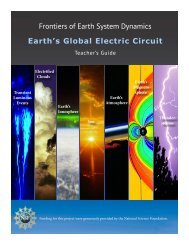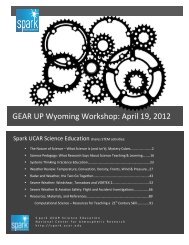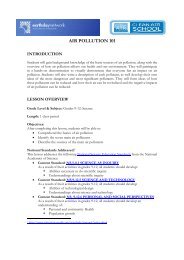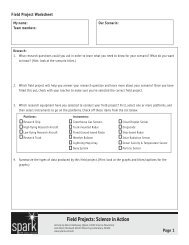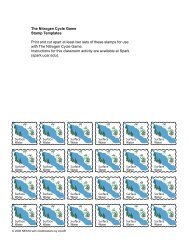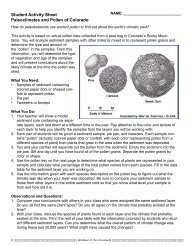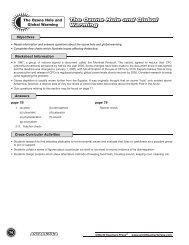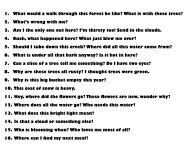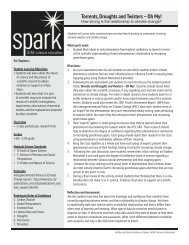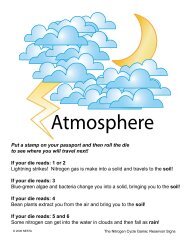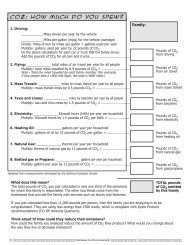#14 - The Six Infamous Pollutants - Salsa!
#14 - The Six Infamous Pollutants - Salsa!
#14 - The Six Infamous Pollutants - Salsa!
You also want an ePaper? Increase the reach of your titles
YUMPU automatically turns print PDFs into web optimized ePapers that Google loves.
oard, under the title: “Sources of Air Pollution.” Cars, trucks, airplanes, power plants, big<br />
factories, fireplaces, and gas stations.<br />
2. Ask students to identify what air pollution is actually made of; if students can name any of<br />
the six major pollutants, applaud them for knowing what so many people don’t know about<br />
the air they are breathing. Ozone (Oз), Carbon Monoxide (CO), Nitrogen Oxides (NOx), Sulfur<br />
Dioxide (SO2), Particulate Matter (PM), and Lead (Pb).<br />
3. Display Reproducible #1 – <strong>Six</strong> <strong>Infamous</strong> <strong>Pollutants</strong> on the projector or smart board for<br />
students to see.<br />
4. Explain to students that there are more pollutants, but that these are the “biggies” and they<br />
should be infamous, but many people don’t know anything about them. Tell them that it<br />
will be their job to find out to find out as much as they can about the pollutants and be able<br />
to share that information with others and make the pollutants “infamous.”<br />
5. Divide the class into six groups and assign each group one of the six infamous pollutants.<br />
Distribute Reproducible #2 – <strong>Six</strong> <strong>Infamous</strong> <strong>Pollutants</strong> Assessment Rubric and<br />
Reproducible #3 – <strong>Infamous</strong> Pollutant Biography.<br />
6. Challenge students to treat the Pollutant as an infamous character about whom they are<br />
putting together a biographical sketch. Tell them to use the EPA pollutants and air quality<br />
websites for kids, listed on the hand-out, as well as encyclopedias or other resources, to<br />
answer the questions and get to know their Pollutant very well. Explain that groups will be<br />
preparing this biographical information for a “Meet the <strong>Pollutants</strong>” Press Conference in<br />
which each type of pollutant will be interviewed to find out what they are all about. (Explain<br />
that infamous people often hold press conferences and answer questions by reporters).<br />
Each person in the group will play a particle of whichever pollutant that group was assigned;<br />
each person will speak at the press conference presentation and tell part of the pollutant's<br />
life story (based on information from Reproducible #3 – <strong>Infamous</strong> Pollutant<br />
Biography); and each person in a group should be prepared to answer questions from the<br />
"press."<br />
7. <strong>The</strong> rest of the class will take notes and ask questions, acting as members of the press. Tell<br />
students that the groups may use props, special effects, or simple costumes to make the<br />
invisible pollutant visible and interesting to others. Mention that props also make good<br />
memory devices and help keep a presentation on track. Tell students that each group should<br />
have a main point or focus of its presentation, instead of just reciting a list of facts. For<br />
instance, a pollutant group could emphasize that their pollutant kills kids, or is the most<br />
dangerous, or had a difficult childhood, is not very threatening at all~ and explain how or<br />
why. A sample student presentation is included at the end of this document. Explain to<br />
students that for all activities in this lesson, they should follow the guidelines on the<br />
assessment rubric. At the end of the lesson, the teacher will collect the assessment rubric<br />
and grade accordingly. Be sure to mention that students should fill out the “Self-<br />
Assessment” portion of the rubric to get 5 extra points toward their overall grade.<br />
presentations.<br />
8. As students research and develop materials, circulate and assist them as needed. Encourage<br />
them to be creative yet scientifically accurate. Emphasize that each member of the group<br />
must participate in the presentation, and that each person must fill out his own version of<br />
the Reproducible #3 – <strong>Infamous</strong> Pollutant Biography, even if group members<br />
collaborate on the research. Allow time for the groups to plan and practice their<br />
presentations, after research is complete.<br />
Earth Day Network<br />
1616 P Street NW, Suite 340 Washington, DC 20036<br />
(P) 202-518-0044 (F) 202-518-8794<br />
www.earthday.org/education education@earthday.org




